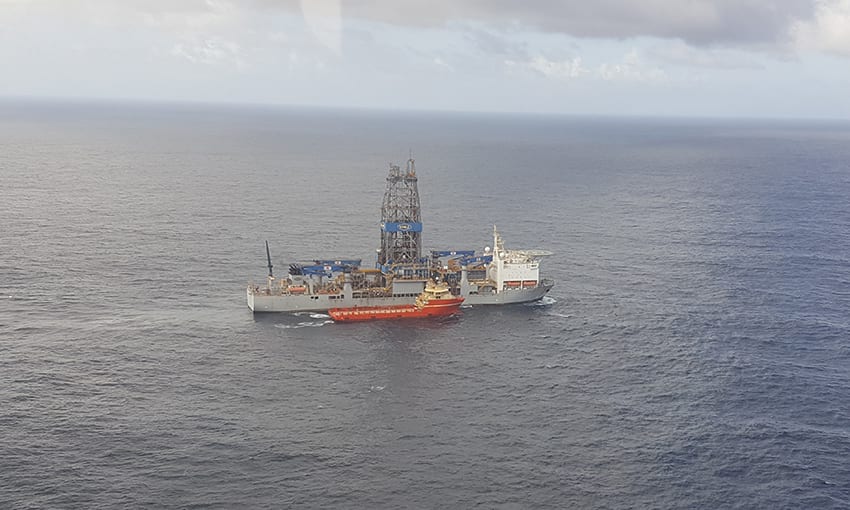(S&P Global Platts) Total and Apache Corp. will continue their oil exploration program offshore of Suriname after ceasing drilling in one key test well upon facing “substantial pressure increases,” but only after they had already struck oil at shallower depths.
The Total and Apache joint venture is attempting to turn the small South American nation into the world’s next oil frontier just as ExxonMobil has done with neighboring Guyana. Total and Apache have announced four Suriname discoveries since the beginning of 2020, and ExxonMobil and Petronas recently made their first discovery on the Suriname side of the international Atlantic waters.
Big Guyana oil finds embolden Suriname explorers – deepwater set to flourish
Apache said the Keskesi East-1 well, which struck oil in the Upper Cretaceous-aged depths in January, has ceased its drilling operations as it sought additional crude oil deposits in the deeper Neocomian-aged targets.
“As drilling progressed, the well encountered substantial pressure increases that APA and Total determined could ultimately exceed the capabilities of the wellbore design and pressure control equipment,” Apache said in a statement. “Consequently, the partners decided to conclude drilling operations at Keskesi before reaching the Neocomian targets.”
They will now work on designing a new wellbore and drilling program for a safer test of the deep Neocomian targets in future exploration.
While the announcement is not good news for the Suriname exploration, said RBC Capital Markets analyst Scott Hanold, it should not be considered discouraging either.
The most likely scenario is Total, and Apache announce a final investment decision late this year to target production in shallower depths off of Suriname, he said.
“I think there’s still potential there. I don’t think you need this to make the (Neocomian) play. I think it’s additive,” Hanold said. “It just takes a little icing off the cake on the upside.”
But first oil is still at least four years away, he cautioned, so there remains a long way to go.
Suriname looking to follow Guyana in major oil production ramp up, no plans to delay
Apache emphasized that the additional drilling at the Keskesi East-1 well did still encounter in the Lower Cretaceous depths, as well as a “carbonate depositional system” above the top Neocomian target. Apache called the finds “encouraging,” while cautioning that the data did not reveal specific information about the Neocomian targets themselves.
The Block 58 joint venture is a Total-operated 50-50 split with Apache since the beginning of 2020.
Keskesi is the easternmost of the four discoveries. The next well in the exploration queue is Bonboni, on the northern portion of Block 58.
Apache’s capital budget for 2021 is $1.1 billion, up 11% year on year. This includes $200 million for exploration in Suriname for a two-rig appraisal and exploration program in the country.
How we got here
Now that ExxonMobil has made a whopping 18 Guyana discoveries to date on the Stabroek block, the natural line of thinking was whether similar crude oil discoveries could come from neighboring waters.
With struggling Venezuela on the other side of Guyana, the focus shifted to Suriname with Apache seizing the lead before being joined by Total.
In January, their Keskesi East-1 well encountered a total of 206 meters net pay consisting of black oil, volatile oil and gas pay in good quality reservoirs after being drilled to a water depth of about 2,400 feet, the companies said.
In early 2020, the partners announced the Maka Central-1 discovery, which found 240 feet of oil pay and 164 meters of light oil and gas condensate pay. The subsequent large discoveries at Sapakara West and Kwaskwasi have supported expectations that Block 58 could be prolific.
Also, ExxonMobil and Malaysia’s Petronas in December announced an offshore Suriname discovery named Sloanea on Block 52, east of Total-Apache’s Block 58.
Petronas operates the block as part of the 50-50 JV.
In Guyana, ExxonMobil and partners Hess Corp. and China’s CNOOC began production in December 2019 at the Liza Field, their first discovery on the Stabroek block. Since then, they have sanctioned a second project at Liza Phase 2 and a third project, Payara, which are expected to come online roughly in early 2022 and 2024, respectively.
Liza Phase 1 can produce up to 120,000 b/d, ExxonMobil said, while the two newer developments are designed to produce up to 220,000 b/d each.



